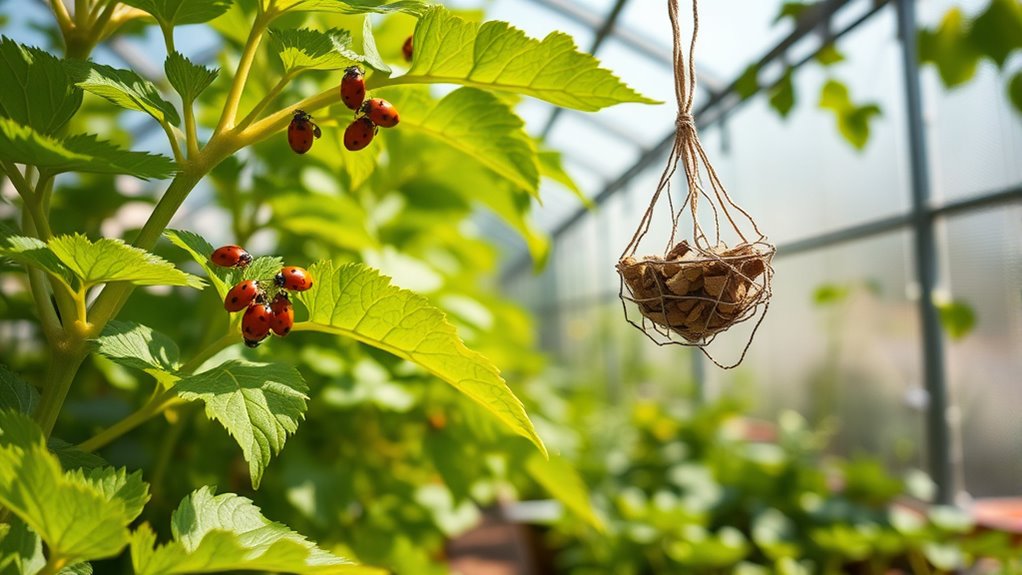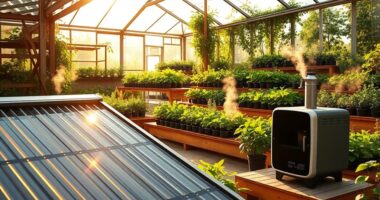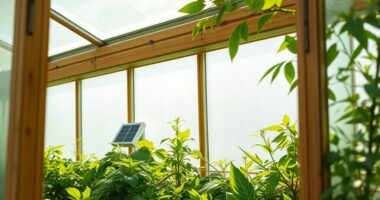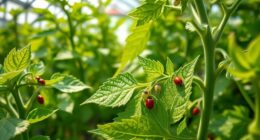To implement sustainable pest control in your greenhouse, focus on biological methods like introducing beneficial insects and encouraging natural predators. Combine this with cultural practices such as crop rotation, sanitation, and selecting pest-resistant plants. Use organic pesticides and natural repellents, and employ companion planting to deter pests. Maintain ideal environmental conditions like temperature, humidity, and airflow for healthy plants. Keep pests in check with monitoring and integrated pest management strategies. Discover more ways to balance eco-friendly practices effectively.
Key Takeaways
- Implement biological control agents like ladybugs and parasitic wasps to naturally reduce pest populations.
- Use integrated pest management (IPM) combining cultural, mechanical, and biological practices for eco-friendly pest control.
- Enhance plant health and pest resistance through crop rotation, companion planting, and maintaining optimal environmental conditions.
- Utilize organic pesticides such as neem oil, garlic, or chili extracts to deter pests without harming the ecosystem.
- Promote biodiversity by preserving beneficial insects, birds, and habitat diversity to naturally suppress pest outbreaks.
Biological Control Strategies

Have you ever considered using natural predators to manage pests? Biological control strategies involve introducing beneficial insects that prey on pest insects within your greenhouse. These beneficial insects target specific pest habitats, helping to reduce populations naturally without chemicals.
For example, ladybugs feed on aphids, while parasitic wasps target whiteflies. By encouraging these beneficial insects, you create a balanced ecosystem that minimizes pest outbreaks. It’s essential to understand where pests thrive, as pest habitats often cluster in certain areas, making targeted release effective.
Biological control offers a sustainable, eco-friendly alternative to chemical pesticides, promoting healthier plants and a safer environment. When properly implemented, it can markedly decrease pest numbers and improve overall crop health.
Cultural and Mechanical Practices
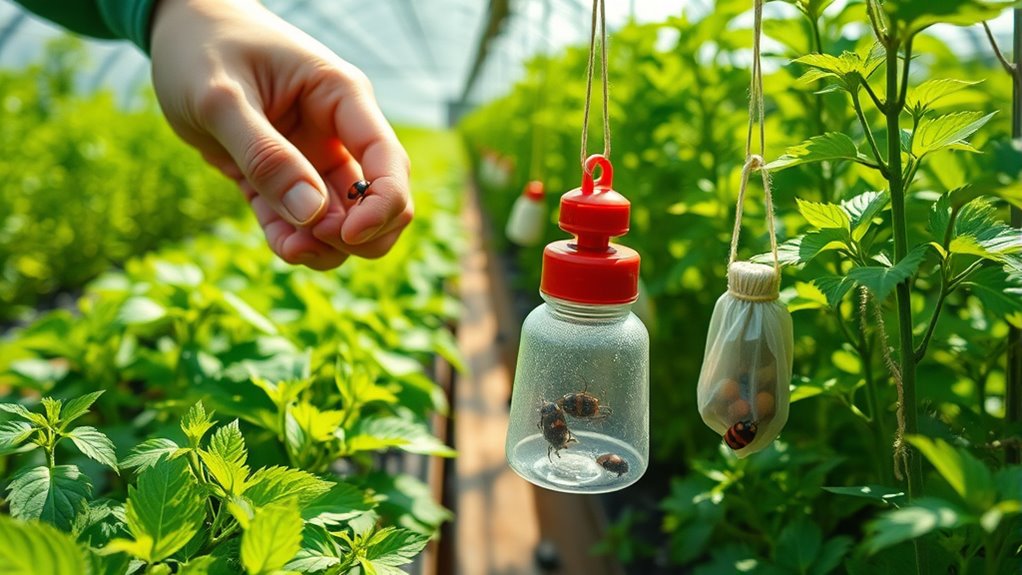
Implementing cultural and mechanical practices is a vital step in sustainable pest management. By focusing on soil health, you can reduce pest problems and improve plant resilience.
Practices like crop rotation help break pest cycles, preventing the buildup of specific pests and diseases in the soil. Rotating crops also promotes diverse soil nutrients, supporting healthy plant growth.
Mechanical methods, such as using physical barriers, hand-picking pests, or installing screens, minimize chemical reliance. Regular sanitation, like removing plant debris and weeds, further reduces pest habitats. Soil health plays a crucial role in enhancing plant vitality and resistance to pests.
Incorporating Vetted electric bike conversion kits as a sustainable transportation option can reduce reliance on fossil fuels, contributing to overall eco-friendly practices in greenhouse management. Additionally, understanding pest identification allows for targeted control measures, reducing unnecessary chemical applications.
These strategies work together to create a healthier greenhouse environment, decreasing pest populations naturally.
Use of Organic Pesticides and Natural Repellents
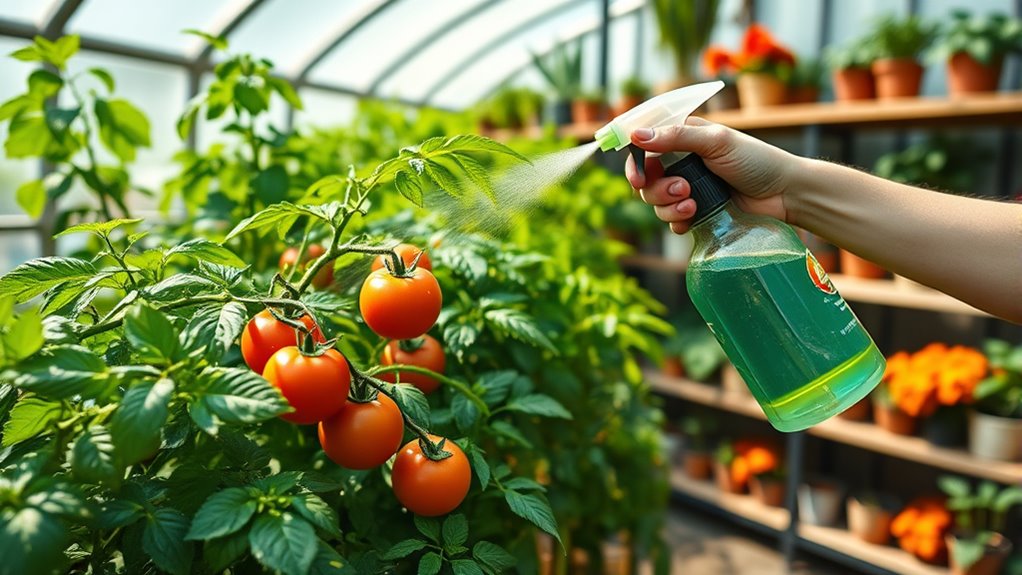
Using organic pesticides and natural repellents can enhance biological pest resistance and reduce reliance on synthetic chemicals. These options often prove effective against pests while being safer for the environment and non-target species. Exploring their benefits helps you adopt more sustainable and eco-friendly pest control strategies. For example, understanding the financial impact of industry competitors can inform more strategic decisions in pest management investments. Additionally, integrating biological control methods can further improve the effectiveness of sustainable pest management approaches. Incorporating integrated pest management strategies can also optimize pest control outcomes while minimizing ecological disruption. Recognizing the market growth of AI tech in related fields can support the development of innovative pest monitoring tools.
Biological Pest Resistance
Biological pest resistance leverages organic pesticides and natural repellents to control pests sustainably. This approach involves enhancing pest resistance development in crops, often through genetic modification, which helps plants fend off pests naturally. By fostering pest-resistant varieties, you reduce reliance on chemical pesticides, supporting environmental health. Additionally, this method can contribute to sustainable pest management by decreasing the ecological footprint of pest control practices. Proper pest resistance development is vital to prevent pests from overcoming defenses and becoming resistant over time. However, developing resistance requires careful management to prevent pests from overcoming defenses. Here’s a deeper look:
| Aspect | Method | Impact |
|---|---|---|
| Genetic modification | Creating pest-resistant crops | Reduces need for external pesticides |
| Pest resistance development | Selective breeding or biotech methods | Improves crop durability |
| Organic pesticides | Biologically derived substances | Minimize chemical residues |
| Natural repellents | Plant-based or mineral-based compounds | Deter pests without toxins |
| Resistance management | Rotating methods to prevent adaptation | Ensures long-term effectiveness |
Additionally, integrating sustainable practices can enhance the effectiveness of biological pest control strategies over time. Implementing integrated pest management approaches that combine biological methods with cultural and mechanical controls can further bolster pest resistance naturally.
Plant-Based Repellent Efficacy
Plant-based repellents and organic pesticides offer an effective, eco-friendly approach to pest control that builds on pest resistance strategies. You can enhance their efficacy through companion planting, which naturally repels pests by pairing plants with pest-resistant traits alongside vulnerable crops.
For example, planting marigolds near vegetables can deter nematodes, while basil repels flies and mosquitoes. These natural repellents are often derived from substances like neem oil, garlic, or chili pepper extracts, which pests find unappealing. Additionally, using electric bikes to monitor and manage garden pests can reduce the need for chemical interventions, supporting a more sustainable approach.
Environmental Safety Benefits
Organic pesticides and natural repellents enhance environmental safety by minimizing chemical runoff and reducing harm to non-target species. This approach promotes pollution reduction, safeguarding water sources from harmful chemicals. Proper application techniques are essential to maximize effectiveness and minimize unintended impacts. By choosing eco-friendly options, you help preserve crucial habitats for beneficial insects, birds, and other wildlife. The benefits include:
- Protecting your greenhouse’s surrounding ecosystem
- Supporting biodiversity and habitat preservation
- Reducing long-term pollution risks
- Ensuring a healthier environment for future generations
These methods create a safer, more sustainable approach to pest control, aligning your efforts with environmental conservation goals. You actively contribute to habitat preservation and pollution reduction, fostering a balanced ecosystem. Implementing payment processing technologies can further enhance the efficiency and security of your operations, ensuring responsible pest management practices. When selecting organic solutions, it is also important to consider sustainable practices to maintain ecological balance effectively. Additionally, integrating integrated pest management techniques can optimize pest control efforts while further minimizing environmental impact. Moreover, understanding the importance of environmental safety can guide you in choosing the most effective and eco-friendly pest control methods.
Embracing organic solutions not only benefits your greenhouse but also helps safeguard the planet for years to come.
Incorporating Companion Planting
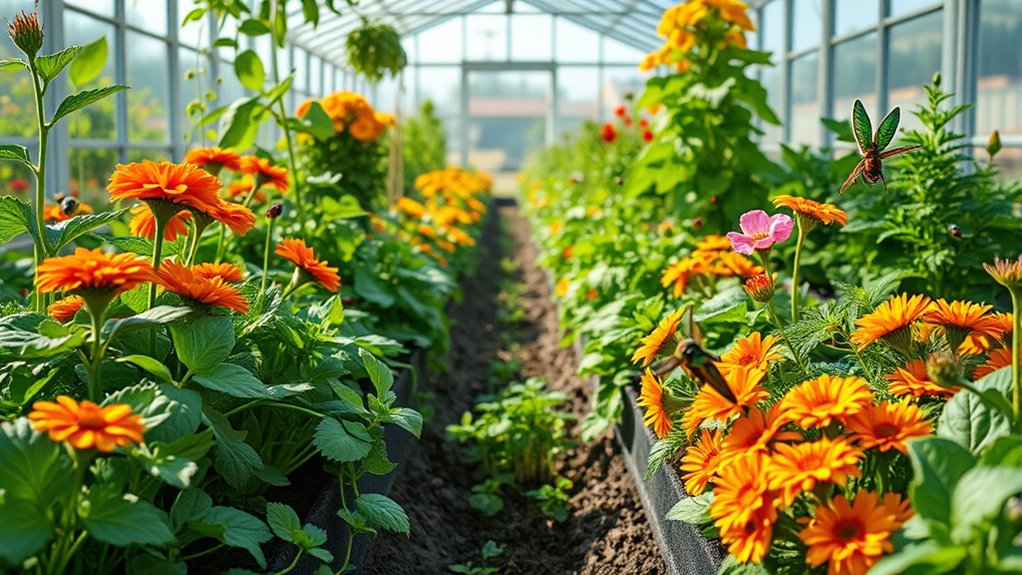
Incorporating companion planting into your garden is an effective way to naturally deter pests and promote healthy growth. By pairing plants strategically, you can attract pollinators that enhance crop productivity and create a balanced ecosystem.
For example, planting flowers like marigolds or basil nearby can draw beneficial insects that prey on common pests. Additionally, increasing crop diversity through companion planting reduces the risk of pest outbreaks by minimizing monocultures, which pests often target. Incorporating positive energy into your gardening routine can further enhance the effectiveness of these natural methods.
This method encourages a resilient garden where beneficial insects thrive, helping to keep pest populations in check without chemicals. You’ll notice healthier plants and more robust yields as a result of these natural interactions, making companion planting a sustainable, eco-friendly approach to pest management.
Regularly monitoring your bike tires for cracks or deformities can ensure your greenhouse plants stay healthy and your bike stays in top condition while you work outdoors.
Maintaining Optimal Environmental Conditions
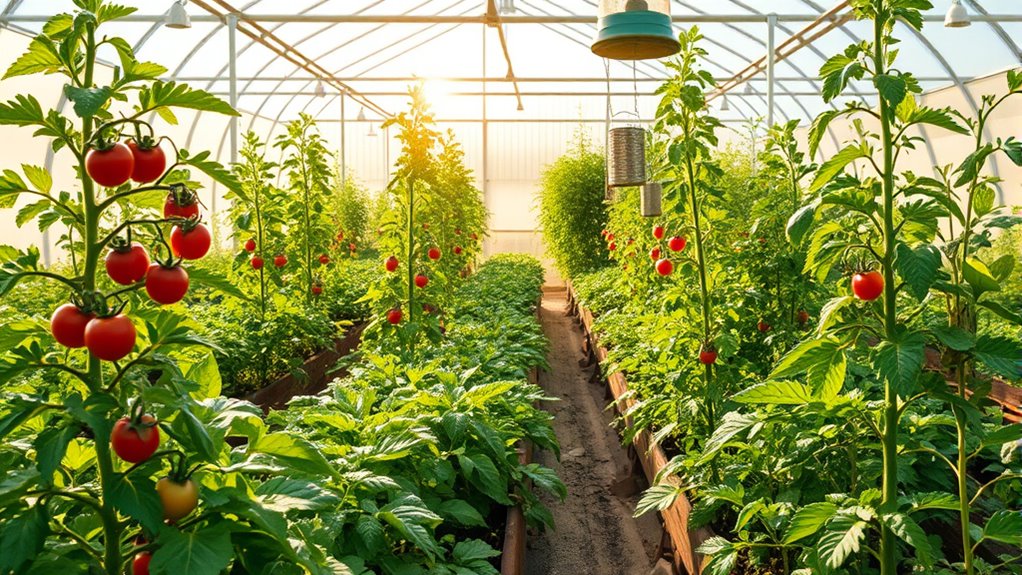
You can reduce pest problems by keeping environmental conditions just right. Adjusting temperature and humidity helps create a less inviting space for pests.
Good air circulation prevents buildup. Managing light and shade guarantees your plants stay healthy and resilient against infestations.
Regulate Temperature and Humidity
Maintaining the right temperature and humidity levels is essential for effective and sustainable pest control. Proper humidity control and temperature regulation help prevent pests from thriving, reducing the need for chemical treatments.
When you optimize these conditions, you create a healthier environment for your plants and a less inviting space for pests.
- Feel confident knowing you’re protecting your crops naturally
- Reduce reliance on harmful pesticides
- Promote stronger, more resilient plants
- Experience peace of mind with a balanced greenhouse environment
Promote Air Circulation Efficiency
Effective air circulation plays a vital role in creating a balanced environment that discourages pests and promotes healthy plant growth. Proper ventilation design ensures consistent airflow, reducing humidity and preventing pest breeding grounds. By optimizing airflow, you enhance plant health and minimize disease risks. Consider the following factors to improve airflow efficiency:
| Ventilation Design | Airflow Optimization | Pest Prevention |
|---|---|---|
| Proper fan placement | Regular maintenance | Reduced mold growth |
| Cross-ventilation | Use of vents | Less insect attraction |
| Natural airflow | Adjusting fan speed | Fewer pest infestations |
| Exhaust systems | Strategic positioning | Healthier plants |
| Shade management | Sealing leaks | Pest population control |
Manage Light and Shade
Controlling light and shade is essential for creating an ideal environment that supports healthy plant growth and pest prevention. Using shade cloths and light filters, you can regulate sunlight exposure, reducing stress on plants and minimizing pest attraction.
Proper shading helps prevent overheating and keeps humidity levels steady, discouraging pests like aphids and whiteflies. By adjusting shade cloths, you create a comfortable microclimate tailored to your crops’ needs.
Consider these steps to optimize your greenhouse:
- Use shade cloths during peak sunlight hours for consistent protection
- Install light filters to diffuse harsh rays and improve plant health
- Regularly check shading systems for damage or misalignment
- Combine shading with good air circulation for a pest-resistant environment
These measures guarantee your plants flourish while naturally deterring pests.
Monitoring and Integrated Pest Management (IPM) Approaches
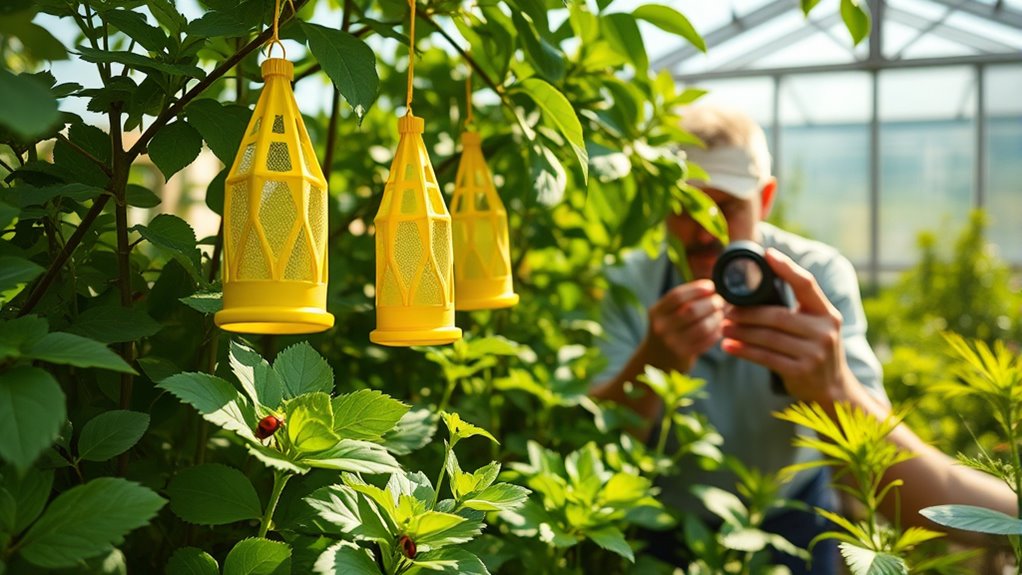
Monitoring is an essential first step in sustainable pest management because it helps you identify pest presence and activity levels accurately. By regularly observing your greenhouse, you can detect pests early and implement targeted control strategies.
Effective monitoring techniques include visual inspections, sticky traps, and pheromone traps, which provide valuable insights into pest populations. Proper pest identification is critical, as it ensures you choose the most appropriate and eco-friendly control methods.
Once pests are identified, integrating this information into your IPM approach allows you to combine cultural, biological, and mechanical controls, reducing reliance on chemicals. This proactive, precise method minimizes environmental impact, promotes plant health, and sustains your greenhouse’s productivity over time.
Frequently Asked Questions
How Do I Select the Best Biological Control Agents for My Greenhouse?
When selecting biological control agents for your greenhouse, consider beneficial insects like ladybugs or predatory mites that target specific pests.
Look for pest-resistant plants to reduce infestation risks.
You should assess your pest types and environmental conditions to choose the most effective beneficial insects.
Always buy from reputable sources to guarantee quality and compatibility.
Regular monitoring helps you evaluate the success of your biological control agents and adjust as needed.
What Are the Cost Differences Between Organic and Conventional Pest Control Methods?
When comparing costs, organic pest control often appears pricier upfront than conventional methods. However, the cost comparison reveals long-term economic benefits like improved plant health and reduced chemical expenses.
While organic solutions may require more initial investment, they promote sustainability and can lower future pest management costs. You’ll find that choosing organic methods offers a balanced approach, providing both environmental advantages and economic savings over time.
How Often Should I Monitor Pests to Ensure Effective Management?
You should monitor pests regularly to guarantee effective management. Typically, pest detection requires you to check your greenhouse at least once a week.
But during high-risk periods, you might need to increase monitoring frequency to every few days. Consistent monitoring helps catch infestations early, allowing you to act quickly.
Keep a detailed record of your observations to identify pest trends and adjust your pest detection strategies accordingly.
Are There Specific Environmental Conditions That Favor Pest Outbreaks?
Think of your greenhouse as a delicate symphony where climate factors set the tempo. Warmth, humidity, and poor ventilation create a cozy habitat for pests, like a playground for troublemakers.
When these conditions align, pests thrive and multiply, turning your lush haven into a battleground.
How Can I Effectively Train Staff on Sustainable Pest Management Practices?
You can effectively train your staff by organizing hands-on workshops that demonstrate sustainable pest management practices, allowing them to practice techniques firsthand.
Additionally, provide thorough training manuals that detail pest control protocols and eco-friendly methods.
Encourage questions and ongoing learning to reinforce concepts.
Regularly evaluate their understanding and offer refresher sessions to ensure everyone stays updated on sustainable practices, ultimately creating a knowledgeable and environmentally conscious team.
Conclusion
By embracing these sustainable pest control methods, you’re planting the seeds for a thriving, balanced greenhouse ecosystem. Think of it as tending a delicate garden where every choice nurtures health and harmony. With each biological control, natural repellent, and careful monitoring, you’re weaving a resilient web that keeps pests at bay without harming your environment. Together, these strategies create a lush, vibrant sanctuary—where your plants flourish in harmony with nature’s gentle touch.
